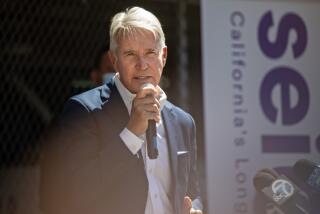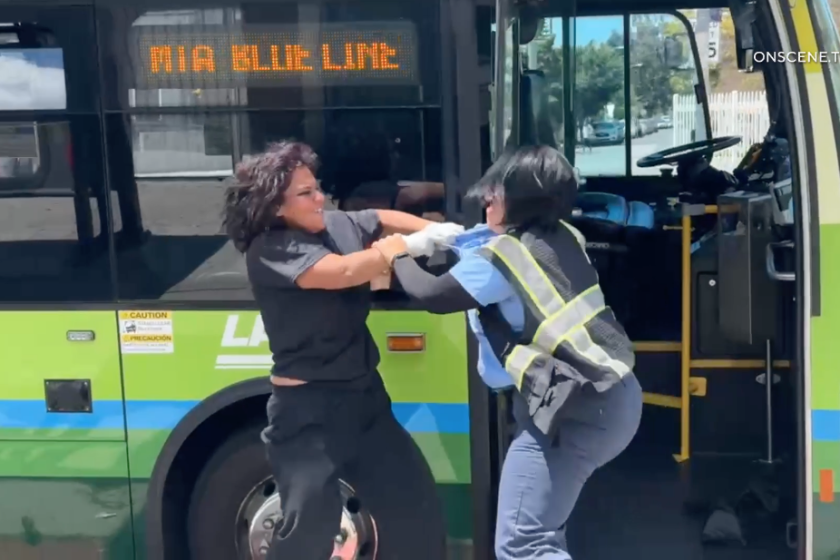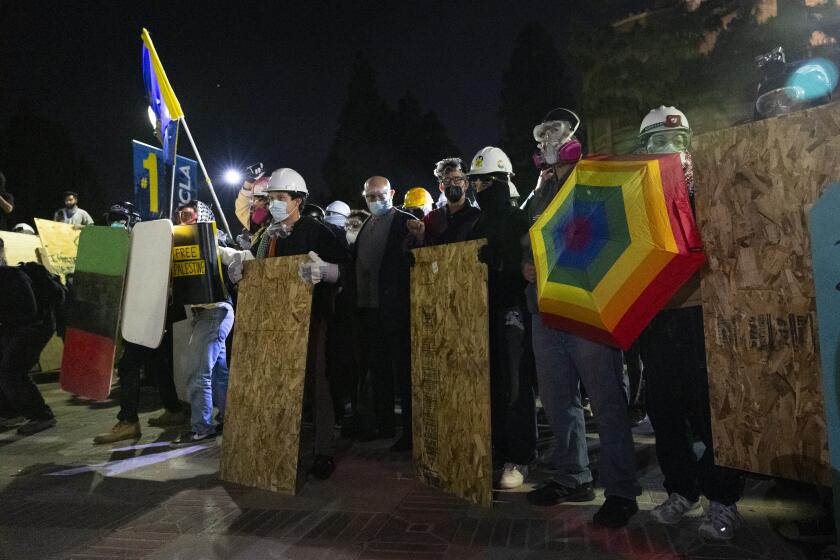Support for Hollywood Secession
Los Angeles voters would decide in November whether Hollywood--as well as the San Fernando Valley--should become independent cities, but would not vote on breaking off the harbor area for at least two years, under recommendations released Tuesday by the head of the agency studying all three plans.
Larry Calemine, executive director of the Local Agency Formation Commission, said he will tell the panel today that Hollywood cityhood would be financially viable and should be placed on the Nov. 5 citywide ballot.
“It is feasible,” Calemine said. “There are sufficient reserves for it to work.”
After a similar recommendation by Calemine, the commission voted 8 to 1 last week to call an election on the Valley breakaway bid. Its decision on Hollywood is due next week.
Calemine also suggested Tuesday that the famed Hollywood sign be included within a new Hollywood city, something Los Angeles officials oppose.
LAFCO will decide today whether to shelve the harbor-area measure, long hampered by financial questions, to allow more analysis. Andrew Mardesich, a leader of the harbor breakaway drive, said Tuesday that he supports the two-year delay. He and other secessionists have disputed the financial assumptions that Calemine used to review the plan.
The harbor’s fate could have important implications for the Valley and Hollywood breakup proposals. To win, each measure needs a majority of votes within the breakaway area and a majority citywide.
Secessionists believe their chances of securing citywide approval are better if all three proposals hit the ballot at the same time.
But some political strategists question that logic, saying that three simultaneous proposals could provoke a backlash.
“It seems to me you could create a fear of three secession operations,” said Joe Cerrell, a veteran Los Angeles political consultant. “Joe and Jane Ordinary Citizen might say, ‘They’ve gone overboard. This is radical. It’s not just the San Fernando Valley, it’s Hollywood and it’s the whole San Pedro port area. My God, what’s going to be left?’”
If LAFCO follows Calemine’s recommendations, voters would be asked in the fall to split the nation’s second-largest city into as many as three parts.
The campaign already is heating up across Los Angeles. City political leaders are amassing a multimillion-dollar fund to fight secession, depicting it as a risky proposition that would jeopardize municipal finances and public safety, while breakup supporters plan a broad grass-roots effort to tap voter discontent over city services.
The Hollywood area is home to about 160,000 people, and the Valley to 1.35 million. Together, they account for 40% of Los Angeles’ population. Calemine’s conclusions follow more than two years of analysis on the three secession proposals, focusing on whether each region could survive financially without harming the remainder of Los Angeles.
For Hollywood, he found that the proposed city would enjoy a budget surplus even after paying Los Angeles up to $20 million a year to make up for tax revenue lost in the split.
“It’s a small price to pay for freedom,” said Hollywood VOTE President Gene La Pietra. “Hollywood has been neglected by the city and it’s down for the last count. This is the last chance to revitalize Hollywood and it will only be done through local control.”
In the recommendations, Calemine said LAFCO should exclude areas west of Fairfax Avenue and south of Melrose Avenue that include the Beverly Center and the new Grove shopping center. The secession proposal originally took in those areas.
City Councilman Tom LaBonge, who represents much of Hollywood, disputed Calemine’s findings and said the proposal should not go before voters.
“Los Angeles is a great city and Hollywood is a great part of Los Angeles,” LaBonge said. “This [new] city will not be able to survive. It will cut up and balkanize areas in Los Angeles and it will be of no benefit.”
LaBonge joined his council colleagues Tuesday in a unanimous vote to oppose the harbor secession plan. The council is expected to adopt a similar resolution against the Hollywood bid next week.
“It’s not going to work now,” said Councilwoman Janice Hahn about the harbor-area secession plan. “I don’t think this new city is going to work in 2004 either, because I don’t think there is any way you can cut this, slice this, dice this, that really makes this city viable unless we forgive all of their debt and we give them all of our assets.”
Calemine recommended on May 11 that LAFCO reject the harbor proposal, finding that a waterfront city, population 141,000, would not be able to pay for the same level of services the area now gets from Los Angeles. He reconsidered that position after receiving more information from the secession camp.
A revised harbor plan--complicated by proposed boundary changes and a scheme to contract with Los Angeles County rather than the city of Los Angeles for services--requires more analysis, Mardesich said.
“People will get an accurate study this time,” he said. “No more of this big broad-brush thing. We were always under the shadow of the Valley [secession proposal]. Our objections and our issues weren’t addressed until recently.”
Over the last year, LAFCO repeatedly has raised questions about the harbor area’s financial strength. The area has a weak retail base, with no regional mall that generates sales tax dollars.
State Controller Kathleen Connell, in a review of Calemine’s report, agreed that the area would not be fiscally viable. The proposal was further hobbled when the State Lands Commission recommended against including the Port of Los Angeles in the proposed city, denying it about $18 million in yearly revenue.
County Supervisor Yvonne Brathwaite Burke, a LAFCO commissioner, said Tuesday that the harbor plan warrants further study. Diamond Bar Councilwoman Carol Herrera, another commissioner, agreed: “The whole story is not complete. We need to do more studies of the harbor’s fiscal viability and we’re out of time.”
But county Supervisor Zev Yaroslavsky, who also sits on the LAFCO board, said he is skeptical that the harbor proposal will ever fly.
“I want to hear the arguments from the staff as to why they think putting it off makes sense,” said Yaroslavsky, who agreed that the measure should not go on this year’s ballot. “But I think the burden is on the staff to make a case as to what facts they think might change in 18 months.”
The Valley cityhood proposal is in the midst of a routine, 30-day reconsideration period, during which anyone can ask LAFCO to change its decision.
As of Tuesday, Valley neighborhood activist Harry Coleman was the only person to file for a reconsideration.
He argued that LAFCO gave short shrift to the city’s concerns that a split would leave Los Angeles with at least $153 million in centralized costs that it would still have to cover. Coleman is married to former Rep. Bobbi Fiedler, a Valley Republican. Both were once avid secession supporters but now oppose the breakup measure.
*
Times staff writers Kristina Sauerwein and Sharon Bernstein contributed to this story.
More to Read
Start your day right
Sign up for Essential California for news, features and recommendations from the L.A. Times and beyond in your inbox six days a week.
You may occasionally receive promotional content from the Los Angeles Times.







